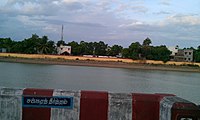The temple priests perform the pooja (rituals) during festivals and on a daily basis. Like other Vishnu temples of Tamil Nadu, the priests belong to the Vaishnavaite community, a Brahmin sub-caste. The temple rituals are performed six times a day: Ushathkalam at 7 a.m., Kalasanthi at 8:00 a.m., Uchikalam at 12:00 p.m., Sayarakshai at 6:00 p.m., Irandamkalam at 7:00 p.m. and Ardha Jamam at 10:00 p.m.
The Vaikhanasa Agama Shastrams and Thengalai Vaishnava traditions are followed in all the temple rituals. Each ritual has three steps: alangaram (decoration), neivethanam (food offering) and deepa aradanai (waving of lamps) for both Adi Jagannatha and Padmasini. During the last step of worship, nagaswaram (pipe instrument) and tavil (percussion instrument) are played, religious instructions in the Vedas (sacred text) are recited by priests, and worshippers prostrate themselves in front of the temple mast.
There are weekly, monthly and fortnightly rituals performed in the temple. The two major festivals celebrated in the temple are the Panguni Brahmotsavam for Adi Jagannathar and Rama Navami Utsavam during the Tamil month of Chittirai. Other major festivals celebrated in Vishnu temples in South India like Vaikunta Ekadashi, Krishna Jayanthi, Pongal and Diwali, are also celebrated.

Chakra Theertham, the temple tank
The temple priests perform the pooja (rituals) during festivals and on a daily basis. Like other Vishnu temples of Tamil Nadu, the priests belong to the Vaishnavaite
The temple is revered in Nalayira Divya Prabandham, the 7th–9th century Vaishnava canon, by Thirumangai Alvar in one hymn. The temple is classified as a Divyadesam, one of the 108 Vishnu temples that are mentioned in the book. The temple is revered in 20 verses of Thirumangai Azhwar in his Periya Thirumozhi in Nalayira Divya Prabandham.The epic is also described by Kambar in his work Kamba Ramayanam.